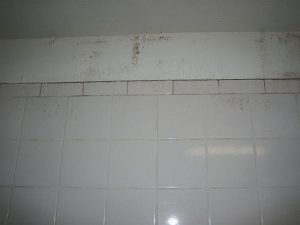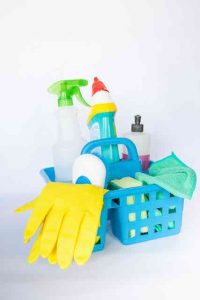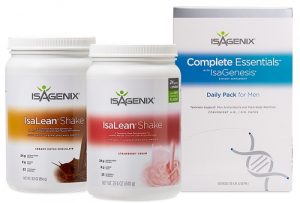Not only is mold ugly and unsightly to look at, but it can also be dangerous to your health. Mold loves to grow in warm damp environments and once it is established, it can wreak havoc on your home and your health. Let’s take a look at what black mold is, ways to prevent it growing and also ways to naturally rid your home of mold.
What is Black Mold?
Black mold is a type of fungi called Stachybotrys chartarum. The fungi reproduce by releasing spores into the air where they land on moist objects and begin to grow. Black mold loves warm, moist environments, such as bathrooms, kitchens, and basements where they thrive in that perfect environment for them. Mold grows on wood, paper, cardboard, towels, curtain, clothes, shoes, and all kinds of other materials.
Molds can be quite damaging to the structure of your home as it eats away the wood, sheetrock, and fabrics. When you have mold in your house, you will usually know it! The smell of mold is quite unpleasant, very musty and damp smelling that you can immediately recognize. Not only is mold bad for your home, but it may also cause health issues, especially for those who are sensitive to it.
Quiz: Is Your Body TOXIC? Take the Test...
(get your free personalized report)
Signs of Mold in Your Home
 When you throw back your shower curtain and see that nasty black stuff along the edges, that is mold. You will also see that type of mold often growing around the edges of your shower, bathtub, sinks, toilets, drain pipes, washing machine and sometimes even in your refrigerator. Watch your sink drains for slimy looking dark molds that may be tinged with a slight orange color as well. You can also smell mold with its damp mustiness. Don’t just ignore the mold – it must be dealt with to help preserve your home and for your health’s sake.
When you throw back your shower curtain and see that nasty black stuff along the edges, that is mold. You will also see that type of mold often growing around the edges of your shower, bathtub, sinks, toilets, drain pipes, washing machine and sometimes even in your refrigerator. Watch your sink drains for slimy looking dark molds that may be tinged with a slight orange color as well. You can also smell mold with its damp mustiness. Don’t just ignore the mold – it must be dealt with to help preserve your home and for your health’s sake.
What Are the Symptoms of Mold Exposure?
Mold exposure symptoms vary, but generally: for mild and short-term exposure, people will generally develop a headache, a cough, have a runny or stuffy nose, itchy, watery eyes, and often dry, scaly skin. If you have a mold allergy or have asthma, the symptoms may be more severe. There may be a tightness in the chest, shortness of breath, wheezing and sustained coughing.
As you can see, these symptoms are similar to cold and flu symptoms as well, so diagnosing mold exposure can be challenging! This is why it is very important that you are aware of signs of mold in your home so that you can identify that mold is growing and that it may just be the culprit of your upper respiratory illness. Check with your doctor if your symptoms are severe.
What are the Dangers of Mold Exposure?
 Black molds produce something called mycotoxins, and they can be quite toxic for some. The Center for Disease Control and Prevention (CDC) states, “All molds should be treated the same with respect to potential health risks and removal.” Black mold exposure often affects the upper respiratory system and is especially harmful if you have asthma or allergies. Prolonged exposure to molds, especially those with allergies or asthma, may result in allergic bronchopulmonary aspergillosis which is a reaction to the fungus in your lungs. Or even worse, can lead to hypersensitive pneumonitis.
Black molds produce something called mycotoxins, and they can be quite toxic for some. The Center for Disease Control and Prevention (CDC) states, “All molds should be treated the same with respect to potential health risks and removal.” Black mold exposure often affects the upper respiratory system and is especially harmful if you have asthma or allergies. Prolonged exposure to molds, especially those with allergies or asthma, may result in allergic bronchopulmonary aspergillosis which is a reaction to the fungus in your lungs. Or even worse, can lead to hypersensitive pneumonitis.
Preventing Mold Growth
 Prevention of mold growth is by far easier than trying to get rid of and eliminate mold once it has become established. Follow these tips to help prevent mold from growing.
Prevention of mold growth is by far easier than trying to get rid of and eliminate mold once it has become established. Follow these tips to help prevent mold from growing.
Quiz: Is Your Body TOXIC? Take the Test...
(personalized report)
- Keep your house clean: The more you wipe and clean, the less chance for mold to establish itself and grow.
- Keep dampness out of your basement: Fix any leaks immediately, and if you sustain water damage, have a water damage restoration crew come and professionally clean the mess up.
- Use a dehumidifier: If you have a room that is susceptible to being damp, such as a basement room, laundry room, or bathroom, consider investing in a dehumidifier for that room. It is advisable to keep the humidity levels below 50 percent to prevent mold growth. If your whole house is damp, consider a whole-home dehumidifier system.
- Use your air conditioner: Running your air conditioner and using high-efficiency particulate air (HEPA) filters can greatly reduce mold exposure. The HEPA filters can trap most mold spores from the outside before they even enter your home. Regularly clean or change the filters.
- Have adequate ventilation: Make sure that all bathrooms and laundry rooms are well-ventilated. Have exhaust fans running (and make sure they are kept clean.) Keep a dehumidifier in damp rooms as well.
- Don’t put carpet in damp rooms: Damp or wet carpets are a great place for mold to grow, so use common sense and don’t put carpeting in places where they may get wet. Use throw rugs that can be cleaned and dried out easily instead.
Tips on Getting Rid of Mold
 Ok, so you have a mold problem. In order to prevent contaminating your home with nasty mold-killing chemicals, let’s take a look at a few ways that you can get rid of it naturally.
Ok, so you have a mold problem. In order to prevent contaminating your home with nasty mold-killing chemicals, let’s take a look at a few ways that you can get rid of it naturally.
- White vinegar: Vinegar is a type of acid and has been found to kill about 82 percent of mold species. Vinegar, when used properly, is non-toxic, and is safe for the environment. You can use vinegar straight or can be mixed with baking soda as well. To use it straight, pour it into a spray bottle. Put on rubber gloves, and perhaps a simple mask or cloth around your nose and spray directly on the mold and wipe clean. If you have moldy clothes, you can soak them in a mixture of 50/50 vinegar and water and then rinse them out.
- Tea Tree Oil: Tea tree oil is a natural fungicide and may be helpful in removing mold. Simply add about 10 drops of tea tree essential oil with a cup of water and spray or wipe on the mold. Leave it on for a few hours for optimum effectiveness.
- Hydrogen peroxide: Mix one teaspoon of peroxide with one cup of water. Spray or wipe on mold and let sit for a few hours and wipe clean.
- Baking soda: Baking soda is a natural disinfectant and it may be helpful to finish off your mold removal tasks by wiping the area with a scrub of 1/2 cup of baking soda mixed with water. Scrub the mixture on the treated areas and then wipe clean with water.
Take Care of Your Body
 If you feel like you have been exposed to mold, you may want to consider treating your body to good wholesome foods, supplements and by drinking plenty of water to help flush the toxins away. In addition, add Isagenix IsaLean Shakes which are chocked full of vitamins, minerals, enzymes, and high-quality protein to your daily diet, along with Isagenix Complete Essentials which is a whole-body nutritional support program. Once a week give your body a break from eating and nourish your cells with nutrient-dense Cleanse for Life drink. By keeping your body healthy and your immune system up-to-par, you can help your body’s systems combat some of the damaging effects of mold exposure.
If you feel like you have been exposed to mold, you may want to consider treating your body to good wholesome foods, supplements and by drinking plenty of water to help flush the toxins away. In addition, add Isagenix IsaLean Shakes which are chocked full of vitamins, minerals, enzymes, and high-quality protein to your daily diet, along with Isagenix Complete Essentials which is a whole-body nutritional support program. Once a week give your body a break from eating and nourish your cells with nutrient-dense Cleanse for Life drink. By keeping your body healthy and your immune system up-to-par, you can help your body’s systems combat some of the damaging effects of mold exposure.
Hopefully, you don’t have mold in your home. By following a few of the tips on preventing mold growth you can help to discourage mold from establishing itself. If you do have mold, follow the tips on naturally cleaning your home to get rid of it, and always, eat healthily, take quality supplements, and nourish your body every day to help your immune system stay strong.

